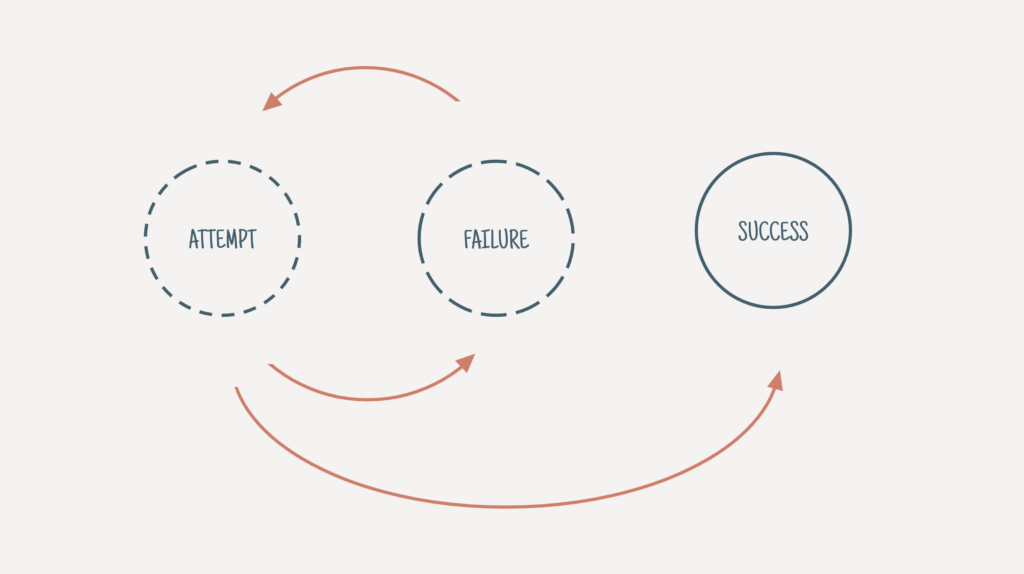When I was younger, I badly wanted to live in Japan. Japan is a country with very strict immigration laws, but my university had an exchange program where you could go spend a semester and study in another country.
There was only one problem: the Japanese university they had a partnership with was one of the most selective in the country. I remember thinking: “There’s no way I’ll get accepted.”
I told my mom about my doubts.
“It’s not your decision to make,” she said.
And, as often, she was right. We constantly limit our options by deciding for others. All I had to do was apply, and it then became the university’s job to accept my application or not.
You’ve probably seen this pattern in yourself and others. It’s far easier not to fail when you haven’t tried. It’s far easier to not be wrong when you’re not putting yourself out there. But when we avoid trying because of fear, we also avoid growth.
We all want to be loved
Fear of failure starts in early childhood. We are social animals and feel the need to be accepted by others, which begins with the acceptance and love of our parents.
In a study looking at the relationship between young athletes and their parents, researchers found a correlation between the parents’ high expectations for achievement and the children’s fear of failure. The more the parents showed a negative reaction to what they perceived as a failure from their kid, the more the kid would fear the consequences of “failing.”
In some people, this can turn into atychiphobia, an irrational and paralyzing fear of failure, often accompanied by an intense feeling of panic or anxiety, and physical symptoms such as difficulty breathing, an unusually fast heart rate, and sweating.
For most people, though, fear of failure manifests itself in a much more subtle way, mainly self-doubt that prevents us from exploring uncertain paths:
- We put off doing things because we’re unsure how they will turn out.
- We avoid situations where we may have to try something new in front of other people.
- We avoid doing things we know will improve our lives because we don’t have all the necessary skills.
- We give ourselves the illusion of growth by reading, researching, watching videos… Anything but doing the thing and risking being judged by others.
But the good news is that nobody is hoping for you to fail. Most people you know would be happy to see you succeed, and the ones who don’t know you don’t care. So how do we shift our perception and turn our fears into experiments?
Increments of curiosity
When you start reading a novel, you rarely expect to finish it in one go. Instead, you will probably read a few chapters, then a few more, until you’re done with the book.
Yet when it comes to personal growth, we often abandon this incremental approach. We design big, hairy, audacious goals then freeze because they feel unreachable.
But just like in science, we can reshape our perception of what’s possible by breaking our journey down into smaller experiments.
“Smaller” doesn’t mean something where you’re certain of succeeding, but rather something small enough that there’s no excuse not to try.
Let’s say you have a fear of public speaking and tell yourself that, in any case, nobody has ever invited you to speak at a conference. Instead of seeing this as an immovable obstacle, turn this big fear into a tiny experiment. A low-stakes pact could be applying to five local meetups to give a talk over the next five days. While speaking in public may sound terrifying, filling out an online form is manageable.
Similarly, if you fear being judged for the quality of your writing, writing a book is a daunting task that is easy to hide behind (“I’d love to write a book, but I don’t have the time”). But writing a series of blog posts? That’s just a tiny experiment.
Fail like a scientist
If you see life as a series of experiments – where the only purpose is to explore, learn, and grow – failure stops being something to fear and instead becomes a necessary part of discovery. In the words of Seth Godin: “The cost of being wrong is less than the cost of doing nothing.”
Scientists often repeat experiments thousands of times to get a conclusive answer. And more often than not, the answer they get is that their initial hypothesis was wrong. Not performing the experiment would have allowed them to stay in a cozy limbo of being not wrong and they’d never learn anything.
Approaching failure like a scientist is powerful because it reframes the outcome: no matter what happens, you gain new information. The real failure isn’t making mistakes – it’s refusing to run the experiment in the first place.
By making decisions that will let you learn something new, you are guaranteed to be successful – where success is learning, evolving, and growing as a human being. Failing becomes a way to cultivate aliveness.

Another way to approach your fears is to think like a child. Children tend to experiment just for the sake of it: What will happen if I press this button? How does it feel to touch this thing?
Similarly, reconnecting with your inner child is a great way to overcome your fears as an adult. For example: What will happen if I publish this post? How does it feel to speak my mind?
Instead of imagining all the ways you may fail, turn your doubts into questions. Maybe nothing good will happen… but a child would certaintly not take the answer for granted.
Start with something small, then move on to another iteration—a bigger growth loop. With time, your mind will become increasingly comfortable with trying new things and constantly expanding your horizons.
Practically, here is how you can start applying this approach of deliberate experimentation right now:
- Pick something you’ve been putting off because of fear. Is it public speaking? Starting a blog? Producing a podcast? Launching your first product? Write it down.
- Define one tiny experiment you can design to explore this fear. It should be actionable – something simple enough that you can just do it in a few days at most.
- Do it! Don’t plan anything. Don’t research the best way to go about it. Don’t announce it on Twitter. Just do it.
- Reflect on what happened. Any negative reactions? What about your emotions? What did you learn? Write all of these thoughts down. It’s a great way to practice metacognition (Plus Minus Next works great for this).
- Rinse and repeat. Keep defining incremental steps in the form of tiny experiments that fall out of your comfort zone but are not scary to the point of being paralyzing. Again, avoid overthinking it beforehand. Just do it, and reflect only after you have performed the experiment.
You may feel some anxiety or discomfort along the way, but addressing your fears and trying new things you care about is the best way to avoid another feeling that’s much harder to manage: regret.
